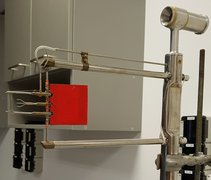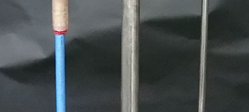Instrument
Ultra-Fast Thermometer 2.0 (UFT-2)
termometr

Ultra-Fast Thermometer 2.0 (UFT-2)
termometr
| Laboratorium: | Laboratorium Mechaniki Płynów |
| Lokalizacja: | ul. Pasteura 5, B4.11 |
| Instytut: | IGF |
| Zakład: | ZFA |
UltraFast Thermometers are the family of miniature temperature sensors developed for airborne measurements of small-scale turbulent fluctuations of air temperature, both in clear air as well as inside the clouds (Haman et al. 1997). The principle of measurement is the temperature-dependent resistance of the platinum-coated tungsten wire. Low heat capacity is ensured by its small diameter (2.5 μm) and relatively short length (3-5 mm). The theoretical response time of the wire depends on the ventilation velocity typical for an airborne platform (e.g. about 0.1 ms at 20 m/s). In practice, the instrument can resolve turbulent fluctuations with a temporal resolution of up to 4 kHz. The electric current is minimized to avoid self-heating, thus the signal is amplified with the use of dedicated analogue amplifier boards.
Currently, there are several models in use:
|
Model |
Characteristics |
Example application |
|
UFT-M |
two sensing wires on a custom prong behind a shielding rod attached to a wind vane which adapts to the flow direction |
Twin Otter aircraft during POST campaign in 2007 (Kumala et al., 2013) |
|
UFT-2-0 |
two sensing wires on a custom prong behind a very close fixed shielding rod |
ACTOS platform (helicopter-borne) during ACORES campaign in 2017 (Siebert et al., 2021) |
|
UFT-2-A |
one sensing wire oriented perpendicular to the mean flow mounted on a Dantec prong (55P01) |
Max Planck CloudKite+ (ballon/kite hybrid platform) during EUREC4A campaign in 2020 (Stevens et al., 2021) |
|
UFT-2-B |
one sensing wire oriented parallel to the mean flow mounted on a Dantec prong (55P03) |
Twin Otter aircraft during EUREC4A campaign in 2020 (Stevens et al., 2021) |
The UltraFast Thermometer 2.0 (UFT-2) of the Institute of Geophysics is a miniature instrument aimed at high-resolution airborne temperature measurements, both in clear air and clouds. In comparison with its predecessors, UFT (Haman et al., 1997) and UFT-M (Kumala et al., 2013), its design involves no moving parts (e.g. wind vane, difficult to certify on a research aircraft) while the whole thermometer is much smaller (pencil size). Miniaturization reduces flow distortion and aerodynamic noise.
Photo 1: UFT-2 instrument mounted at the Fluid Dynamics Lab of IGF-UW for visualization of temperature fluctuations during Science Festival (Fig. Moein Mohammadi).
Photo 2: Different thermometers during an intercomparison experiment (from left to right): UFT-2-B, UFT-M, PT100, Dantec 55P71, UFT-2-A (Fig. Jakub Nowak)
Photo 3: Different thermometers during an intercomparison experiment (from left to right): UFT-2-0, UFT-2-0, PT100 (Fig. Jakub Nowak)



